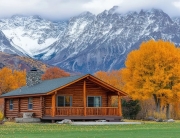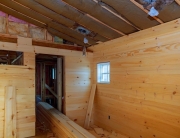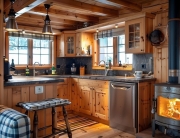If you are contemplating installing knotty pine paneling on your walls or ceilings, you must also be thinking about staining or painting them. Which should you do and how do you apply them? Let’s look at what painters and contractors advise about staining versus painting knotty pine paneling for home and commercial use.
Staining Knotty Pine Paneling
Stain is the recommended finish to apply to knotty pine paneling. It provides many benefits you will appreciate over the years, including:
- Stain soaks into the wood pores
- Highlights natural characteristics
- Only one application is generally needed
- Many colors are available
- It can be applied with a cloth or brush
- Stain is easy to apply, fast-drying, and long-lasting
- It can be sanded off and stained a different color
- A whitewash stain provides a light color
Many variations of water-based and oil-based stains and clear top coat finishes are available. Some high-quality brands include Minwax by Sherwin Williams, Perma-Chink, and Sashco. These products come in satin, semi-gloss, and gloss finishes for your convenience. All of them are durable, non-yellowing, UV-resistant, and uniform in appearance.
Don’t Paint Knotty Pine Paneling
We don’t recommend painting knotty pine paneling because paint sets on top of wood as it dries instead of soaking into the wood pores. Here are some other drawbacks:
- Paint can flake off due to excessive wear
- Hides wood’s natural characteristics
- It can be easily damaged
- Paint cannot be applied with a cloth
- Paint is expensive
- It can require a primer
- Paint may require more than one coat
- Pine resin can bleed through paint
Painting knotty pine paneling does not allow the wood to “breathe,” which is what you want it to do with stain. TIP: The best results are achieved by purchasing high-quality, defect-free pine paneling and applying high-quality stain products.
“If you are contemplating installing knotty pine paneling on your walls or ceilings, you must also be thinking about staining or painting them.”
How To Stain Wood Paneling
 Painters generally agree on the best ways to apply stain. You should use the best quality product you can afford to get amazing results. Put on plastic gloves to protect your hands from becoming discolored and wear a face mask if needed in a confined area. You many want to apply a pre-stain product before applying stain. Here are some professional tips that will help:
Painters generally agree on the best ways to apply stain. You should use the best quality product you can afford to get amazing results. Put on plastic gloves to protect your hands from becoming discolored and wear a face mask if needed in a confined area. You many want to apply a pre-stain product before applying stain. Here are some professional tips that will help:
- Make sure the wood surface is sanded, cleaned, and ready for stain
- Apply stain to the surface that shows and not the back to save money
- Apply it to the sides and ends of paneling if necessary
- Use brushes or roller pads made for the stain you are using
- Decide between oil-based and water-based stains
- Before starting, try the stain on a scrap piece of paneling to check the color
- Apply an even coat of stain and let it dry in a clean environment
- Clean your brush or roller pad immediately after completing the project
If you apply a top clear coat and the wood needs a second one, lightly sand between coats and wipe off the dust. Make sure the first coat is thoroughly dry before proceeding. Water-based stain looks great and is today’s preferred product because it has low volatile organic compounds (VOCs). Oil-based stains are still available and should be applied in a well-ventilated area.
NOTE: These tips are meant for finishing new raw knotty pine paneling. They don’t apply to staining wood that was previously stained or painted unless you first strip off the old finish.
Water-Based Versus Oil-Based Stains
 When choosing between water-based and oil-based wood stains, the key differences lie in drying time, ease of cleanup, and overall durability. Water-based stains dry faster, clean up easily, and are more environmentally friendly. Oil-based stains generally offer deeper color penetration and better longevity. The best choice depends on the specific project and desired outcome. Here are some additional considerations:
When choosing between water-based and oil-based wood stains, the key differences lie in drying time, ease of cleanup, and overall durability. Water-based stains dry faster, clean up easily, and are more environmentally friendly. Oil-based stains generally offer deeper color penetration and better longevity. The best choice depends on the specific project and desired outcome. Here are some additional considerations:
| Key Considerations | Water-Based Stains | Oil-Based Stains |
| Drying Time | Fast drying | Slower drying |
| Cleanup | Cleans with soap and water | Cleans with mineral spirits |
| Color Penetration | Less penetration into wood
Somewhat less vibrant color |
More penetration into wood
Richer more vibrant color |
| Durability | Less durable and resistant to wear and tear | More durable and less resistant to wear and tear |
| Outdoor Use | Better for indoor use | Better for outdoor uses |
| Environmental Impact | More eco-friendly with less VOCs than oil-based stain | Higher VOCs in general |
| Using Dense Hardwoods | Less penetration into wood | Better penetration into wood |
In Summary
Wood stains are ideal for finishing knotty pine paneling for walls, ceilings, flooring, and other projects. Both water-based and oil-based stains are amazing products. Use the ideas covered in this article to make the best decisions for your projects.







Recent Comments